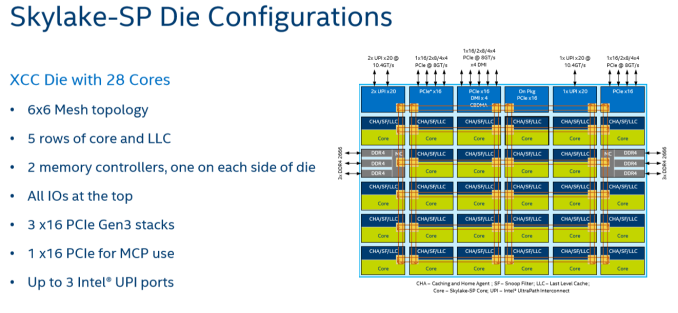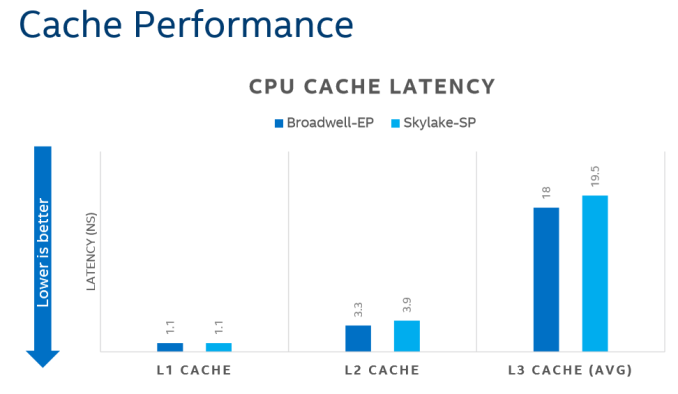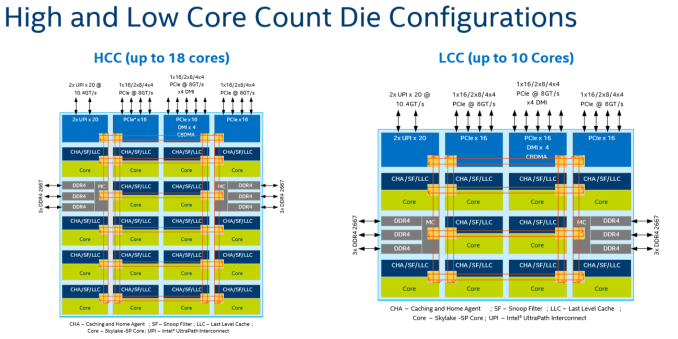Sizing Up Servers: Intel's Skylake-SP Xeon versus AMD's EPYC 7000 - The Server CPU Battle of the Decade?
by Johan De Gelas & Ian Cutress on July 11, 2017 12:15 PM EST- Posted in
- CPUs
- AMD
- Intel
- Xeon
- Enterprise
- Skylake
- Zen
- Naples
- Skylake-SP
- EPYC
Intel's New On-Chip Topology: A Mesh
Since the introduction of the "Nehalem" CPU architecture – and the Xeon 5500 that started almost a decade-long reign for Intel in the datacenter – Intel's engineers have relied upon a low latency, high bandwidth ring to connect their cores with their caches, memory controllers, and I/O controllers.
Intel's most recent adjustment to their ring topology came with the Ivy Bridge-EP (Xeon E5 2600 v2) family of CPUs. The top models were the first with three columns of cores connected by a dual ring bus, which utilized both outer and inner rings. The rings moved data in opposite directions (clockwise/counter-clockwise) in order to minimize latency by allowing data to take the shortest path to the destination. As data is brought onto the ring infrastructure, it must be scheduled so that it does not collide with previous data.
The ring topology had a lot of advantages. It ran very fast, up to 3 GHz. As result, the L3-cache latency was pretty low: if the core is lucky enough to find the data in its own cache slice, only one extra cycle is needed (on top of the normal L1-L2-L3 latency). Getting a cacheline of another slice can cost up to 12 cycles, with an average cost of 6 cycles.
However the ring model started show its limits on the high core count versions of the Xeon E5 v3, which had no less than four columns of cores and LLC slices, making scheduling very complicated: Intel had to segregate the dual ring buses and integrate buffered switches. Keeping cache coherency performant also became more and more complex: some applications gained quite a bit of performance by choosing the right snoop filter mode (or alternatively, lost a lot of performance if they didn't pick the right mode). For example, our OpenFOAM benchmark performance improved by almost 20% by choosing "Home Snoop" mode, while many easy to scale, compute-intensive applications preferred "Cluster On Die" snooping mode.
In other words, placing 22 (E7:24) cores, several PCIe controllers, and several memory controllers was close to the limit what a dual ring could support. In order to support an even larger number of cores than the Xeon v4 family, Intel would have to add a third ring, and ultimately connecting 3 rings with 6 columns of cores each would be overly complex.
Given that, it shouldn't come as a surprise that Intel's engineers decided to use a different topology for Skylake-SP to connect up to 28 cores with the "uncore." Intel's new solution? A mesh architecture.
Under Intel's new topology, each node – a caching/home agent, a core, and a chunk of LLC – is interconnected via a mesh. Conceptually it is very similar to the mesh found on Xeon Phi, but not quite the same. In the long-run the mesh is far more scalable than Intel's previous ring topology, allowing Intel to connect many more nodes in the future.
How does it compare to the ring architecture? The Ring could run at up to 3 GHz, while the current mesh and L3-cache runs at at between 1.8GHZ and 2.4GHz. On top of that, the mesh inside the top Skylake-SP SKUs has to support more cores, which further increases the latency. Still, according to Intel the average latency to the L3-cache is only 10% higher, and the power usage is lower.
A core that access an L3-cache slice that is very close (like the ones vertically above each other) gets an additional latency of 1 cycle per hop. An access to a cache slice that is vertically 2 hops away needs 2 cycles, and one that is 2 hops away horizontally needs 3 cycles. A core from the bottom that needs to access a cache slice at the top needs only 4 cycles. Horizontally, you get a latency of 9 cycles at the most. So despite the fact that this Mesh connects 6 extra cores verse Broadwell-EP, it delivers an average latency in the same ballpark (even slightly better) as the former's dual ring architecture with 22 cores (6 cycles average).
Meanwhile the worst case scenario – getting data from the right top node to the bottom left node – should demand around 13 cycles. And before you get too concerned with that number, keep in mind that it compares very favorably with any off die communication that has to happen between different dies in (AMD's) Multi Chip Module (MCM), with the Skylake-SP's latency being around one-tenth of EPYC's. It is crystal clear that there will be some situations where Intel's server chip scales better than AMD's solution.
There are other advantages that help Intel's mesh scale: for example, caching and home agents are now distributed, with each core getting one. This reduces snoop traffic and reduces snoop latency. Also, the number of snoop modes is reduced: no longer do you need to choose between home snoop or early snoop. A "cluster-on-die" mode is still supported: it is now called sub-NUMA Cluster or SNC. With SNC you can divide the huge Intel server chips into two NUMA domains to lower the latency of the LLC (but potentially reduce the hitrate) and limit the snoop broadcasts to one SNC domain.














219 Comments
View All Comments
msroadkill612 - Wednesday, July 12, 2017 - link
It looks interesting. Do u have a point?Are you saying they have a place in this epyc debate? using cheaper ddr3 ram on epyc?
yuhong - Friday, July 14, 2017 - link
"We were told from Intel that ‘only 0.5% of the market actually uses those quad ranked and LR DRAMs’, "intelemployee2012 - Wednesday, July 12, 2017 - link
what kind of a forum and website is this? we can't delete the account, cannot edit a comment for fixing typos, cannot edit username, cannot contact an admin if we need to report something. Will never use these websites from now on.Ryan Smith - Wednesday, July 12, 2017 - link
"what kind of a forum and website is this?"The basic kind. It's not meant to be a replacement for forums, but rather a way to comment on the article. Deleting/editing comments is specifically not supported to prevent people from pulling Reddit-style shenanigans. The idea is that you post once, and you post something meaningful.
As for any other issues you may have, you are welcome to contact me directly.
Ranger1065 - Thursday, July 13, 2017 - link
That's a relief :)iwod - Wednesday, July 12, 2017 - link
I cant believe what i just read. While I knew Zen was good for Desktop, i expected the battle to be in Intel's flavour on the Server since Intel has years to tune and work on those workload. But instead, we have a much CHEAPER AMD CPU that perform Better / Same or Slightly worst in several cases, using much LOWER Energy during workload, while using a not as advance 14nm node compared to Intel!And NO words on stability problems from running these test on AMD. This is like Athlon 64 all over again!
pSupaNova - Wednesday, July 12, 2017 - link
Yes it is.But this time much worse for Intel with their manufacturing lead shrinking along with their workforce.
Shankar1962 - Wednesday, July 12, 2017 - link
Competition has spoiled the naming convention Intels 14 === competetions 7 or 10Intel publicly challenged everyone to revisit the metrics and no one responded
Can we discuss the yield density and scaling metrics? Intel used to maintain 2year lead now grew that to 3-4year lead
Because its vertically integrated company it looks like Intel vs rest of the world and yet their revenue profits grow year over year
iwod - Thursday, July 13, 2017 - link
Grew to 3 - 4 years? Intel is shipping 10nm early next year in some laptop segment, TSMC is shipping 7nm Apple SoC in 200M yearly unit quantity starting next September.If anything the gap from 2 - 3 years is now shrink to 1 to 1.5 year.
Shankar1962 - Thursday, July 13, 2017 - link
Yeah 1-1.5 years if we cheat the metrics when comparison2-3years if we look at metrics accurately
A process node shrink is compared by metrics like yield cost scaling density etc
7nm 10nm etc is just a name